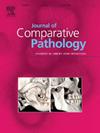Primary intracranial squamous cell carcinoma in a mule
IF 0.8
4区 农林科学
Q4 PATHOLOGY
引用次数: 0
Abstract
Primary intracranial squamous cell carcinoma is a malignant neoplasm reported only in humans and usually originates from epidermoid or dermoid cysts. We describe the first case of primary intracranial squamous cell carcinoma in an animal, emphasizing its clinical, pathological and immunohistochemical findings. A 15-year-old male mule was euthanized after bilateral blindness. At necropsy, the optic nerve, optic chiasm, pituitary gland and trigeminal nerve were surrounded by a multilobulated, firm, whitish mass interspersed by yellowish, irregular, friable multifocal areas of cavitation. Histologically, the mass was formed of neoplastic pleomorphic squamous epithelial cells that formed nests and sometimes contained areas with keratin pearls. Neoplastic cells were immunopositive for cytokeratin and immunonegative for vimentin and alpha fetoprotein. We conclude that primary intracranial squamous cell carcinoma can occur in animals and result in neurological signs, and should be considered as a differential diagnosis for diseases of the central nervous system.
骡子原发性颅内鳞状细胞癌
原发性颅内鳞状细胞癌是一种仅在人类中报道的恶性肿瘤,通常起源于表皮样囊肿或皮样囊肿。我们描述了第一例原发性颅内鳞状细胞癌的动物,强调其临床,病理和免疫组织化学的发现。一头15岁的雄性骡子在双侧失明后被安乐死。尸检时,视神经、视交叉、垂体和三叉神经被一个多分叶状、坚硬的白色肿块包围,其间散布着淡黄色、不规则、易碎的多灶空化区。组织学上,肿块由肿瘤多形性鳞状上皮细胞形成巢状,有时包含角蛋白珍珠区。肿瘤细胞角蛋白免疫阳性,波形蛋白和甲胎蛋白免疫阴性。我们得出结论,原发性颅内鳞状细胞癌可发生在动物身上并导致神经系统症状,应被视为中枢神经系统疾病的鉴别诊断。
本文章由计算机程序翻译,如有差异,请以英文原文为准。
求助全文
约1分钟内获得全文
求助全文
来源期刊
CiteScore
1.60
自引率
0.00%
发文量
208
审稿时长
50 days
期刊介绍:
The Journal of Comparative Pathology is an International, English language, peer-reviewed journal which publishes full length articles, short papers and review articles of high scientific quality on all aspects of the pathology of the diseases of domesticated and other vertebrate animals.
Articles on human diseases are also included if they present features of special interest when viewed against the general background of vertebrate pathology.

 求助内容:
求助内容: 应助结果提醒方式:
应助结果提醒方式:


